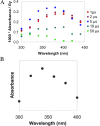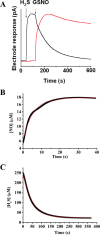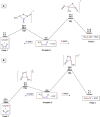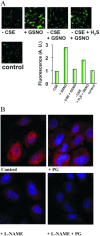Chemical characterization of the smallest S-nitrosothiol, HSNO; cellular cross-talk of H2S and S-nitrosothiols
- PMID: 22741609
- PMCID: PMC3408084
- DOI: 10.1021/ja3009693
Chemical characterization of the smallest S-nitrosothiol, HSNO; cellular cross-talk of H2S and S-nitrosothiols
Abstract
Dihydrogen sulfide recently emerged as a biological signaling molecule with important physiological roles and significant pharmacological potential. Chemically plausible explanations for its mechanisms of action have remained elusive, however. Here, we report that H(2)S reacts with S-nitrosothiols to form thionitrous acid (HSNO), the smallest S-nitrosothiol. These results demonstrate that, at the cellular level, HSNO can be metabolized to afford NO(+), NO, and NO(-) species, all of which have distinct physiological consequences of their own. We further show that HSNO can freely diffuse through membranes, facilitating transnitrosation of proteins such as hemoglobin. The data presented in this study explain some of the physiological effects ascribed to H(2)S, but, more broadly, introduce a new signaling molecule, HSNO, and suggest that it may play a key role in cellular redox regulation.
Figures










Similar articles
-
Rational Design of a Dual-Reactivity-Based Fluorescent Probe for Visualizing Intracellular HSNO.Angew Chem Int Ed Engl. 2019 Nov 4;58(45):16067-16070. doi: 10.1002/anie.201908950. Epub 2019 Sep 24. Angew Chem Int Ed Engl. 2019. PMID: 31479578 Free PMC article.
-
Mechanisms of S-nitrosothiol formation and selectivity in nitric oxide signaling.Curr Opin Chem Biol. 2012 Dec;16(5-6):498-506. doi: 10.1016/j.cbpa.2012.10.016. Epub 2012 Nov 3. Curr Opin Chem Biol. 2012. PMID: 23127359 Free PMC article. Review.
-
Nitrosopersulfide (SSNO(-)) accounts for sustained NO bioactivity of S-nitrosothiols following reaction with sulfide.Redox Biol. 2014 Jan 11;2:234-44. doi: 10.1016/j.redox.2013.12.031. eCollection 2014. Redox Biol. 2014. PMID: 24494198 Free PMC article.
-
On the possible biological relevance of HSNO isomers: a computational investigation.Phys Chem Chem Phys. 2014 May 14;16(18):8476-86. doi: 10.1039/c4cp00469h. Phys Chem Chem Phys. 2014. PMID: 24667901
-
S-nitrosoglutathione.Biochim Biophys Acta. 2013 May;1830(5):3173-81. doi: 10.1016/j.bbagen.2013.02.004. Epub 2013 Feb 14. Biochim Biophys Acta. 2013. PMID: 23416062 Free PMC article. Review.
Cited by
-
Interaction of messengers--endogenous NO and H2S gasotransmitters--in signaling and regulatory processes in bacterial cells.Dokl Biochem Biophys. 2015;461:114-8. doi: 10.1134/S1607672915020131. Epub 2015 May 5. Dokl Biochem Biophys. 2015. PMID: 25937228 No abstract available.
-
Modes of physiologic H2S signaling in the brain and peripheral tissues.Antioxid Redox Signal. 2015 Feb 10;22(5):411-23. doi: 10.1089/ars.2014.5917. Epub 2014 May 9. Antioxid Redox Signal. 2015. PMID: 24684551 Free PMC article. Review.
-
Protein Persulfidation in Plants: Function and Mechanism.Antioxidants (Basel). 2021 Oct 16;10(10):1631. doi: 10.3390/antiox10101631. Antioxidants (Basel). 2021. PMID: 34679765 Free PMC article. Review.
-
The evolving landscape for cellular nitric oxide and hydrogen sulfide delivery systems: A new era of customized medications.Biochem Pharmacol. 2020 Jun;176:113931. doi: 10.1016/j.bcp.2020.113931. Epub 2020 Mar 26. Biochem Pharmacol. 2020. PMID: 32224139 Free PMC article. Review.
-
Homocysteine in renovascular complications: hydrogen sulfide is a modulator and plausible anaerobic ATP generator.Nitric Oxide. 2014 Sep 15;41:27-37. doi: 10.1016/j.niox.2014.06.006. Epub 2014 Jun 22. Nitric Oxide. 2014. PMID: 24963795 Free PMC article. Review.
References
-
- Koppenol W. H. Free Radical Biol. Med. 1998, 25, 385–391. - PubMed
- Ford P. C.; Lorkovic I. Chem. Rev. 2002, 102, 993–1018. - PubMed
- McCleverty J. A. Chem. Rev. 2002, 102, 403–418. - PubMed
- Tennyson A. G.; Lippard S. J. Chem. Biol. 2011, 18, 1211–1220. - PubMed
- Stamler J. S.; Singel D. J.; Loscalzo J. Science 1992, 258, 1898–1902. - PubMed
- Moncada S.; Palmer R. M. J.; Higgs E. A. Pharmacol. Rev. 1991, 43, 109–142. - PubMed
- Calabrese V.; Cornelius C.; Rizzarelli E.; Owen J. B.; Dinkova-Kostova A. T.; Butterfield D. A. Antioxid. Redox Signaling 2009, 11, 2717–2739. - PubMed
- Palmer R. M. J.; Ferrige A. G.; Moncada S. Nature 1987, 327, 524–526. - PubMed
-
- Whiteman M.; Li L.; Kostetski I.; Chu S. H.; Siau J. L.; Bhatia M.; Moore P. K. Biochem. Biophys. Res. Commun. 2006, 343, 303–310. - PubMed
- Yong Q. C.; Hu L. F.; Wang S.; Huang D.; Bian J. S. Cardiovasc. Res. 2010, 88, 482–491. - PubMed
- Ondrias K.; Stasko A.; Cacanyiova S.; Sulova Z.; Krizanova O.; Kristek F.; Malekova L.; Knezl V.; Breier A. Pfluegers Arch. 2008, 457, 271–279. - PubMed
- Sojitra B.; Bulani Y.; Putcha U. K.; Kanwal A.; Gupta P.; Kuncha M.; Banerjee S. K. Mol. Cell. Biochem. 2012, 60, 61–69. - PubMed
- Bertova A.; Cacanyiova S.; Kristek F.; Krizanova O.; Ondrias K.; Tomaskova Z. Gen. Physiol. Biophys. 2010, 29, 402–410. - PubMed
-
- Zhao W.; Wang R. Am. J. Physiol.: Heart Circ. Physiol. 2002, 283, H474–H480. - PubMed
- Mustafa A. K.; Sikka G.; Gazi S. K.; Steppan J.; Jung S. M.; Bhunia A. K.; Barodka V. M.; Gazi F. K.; Barrow R. K.; Wang R.; Amzel L. M.; Berkowitz D. E.; Snyder S. H. Circ. Res. 2011, 109, 1259–1268. - PMC - PubMed
Publication types
MeSH terms
Substances
LinkOut - more resources
Full Text Sources
Other Literature Sources
Molecular Biology Databases

